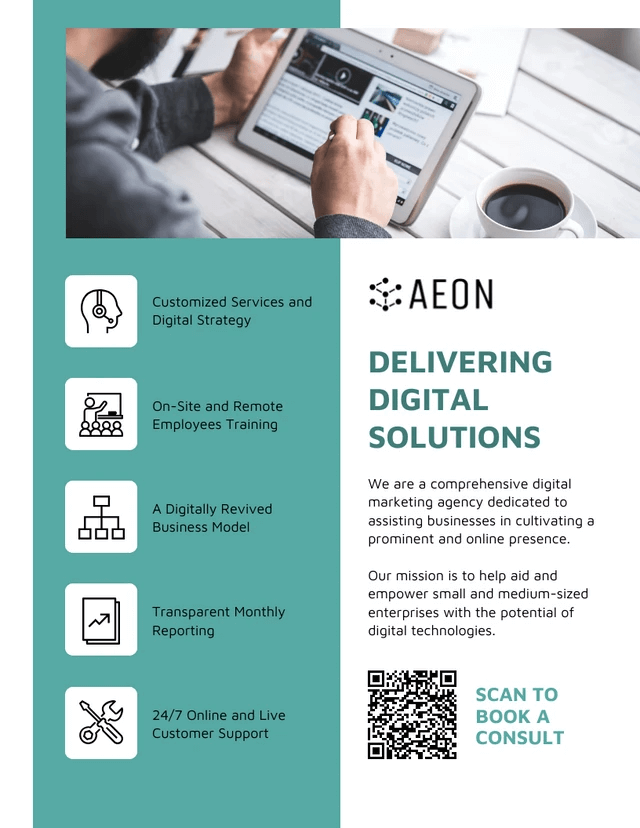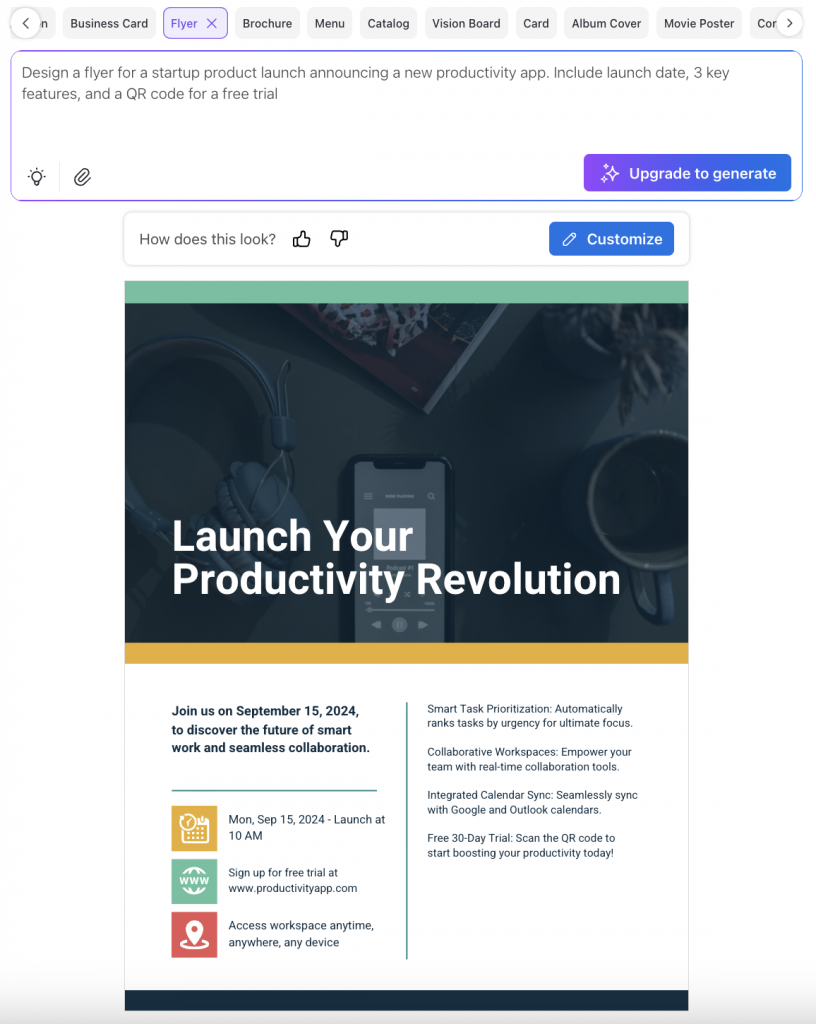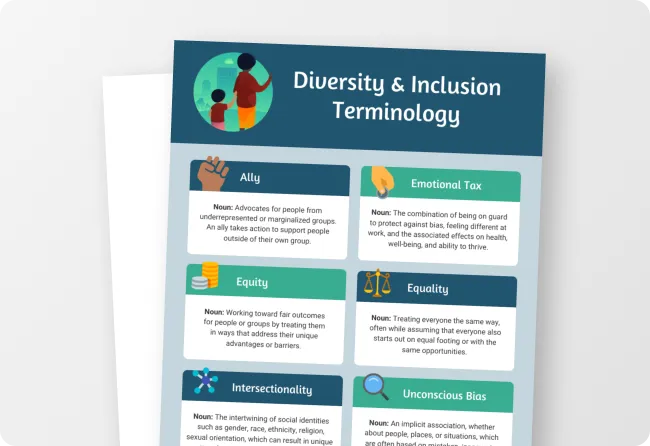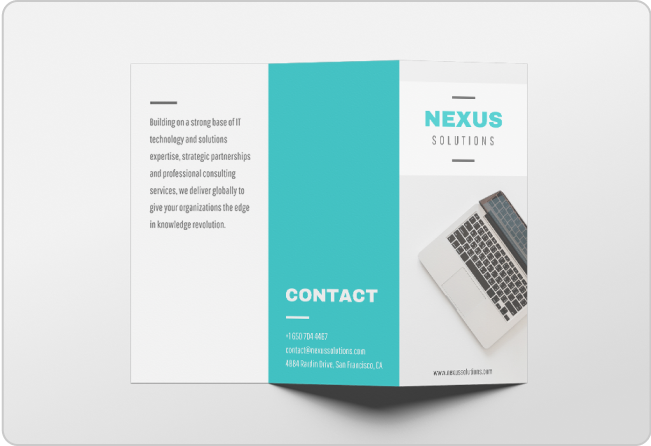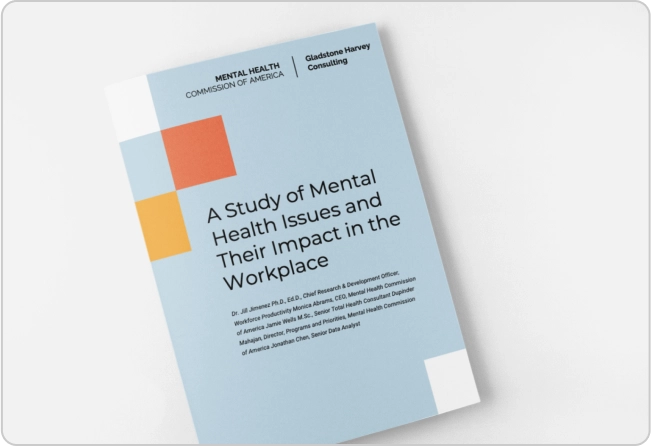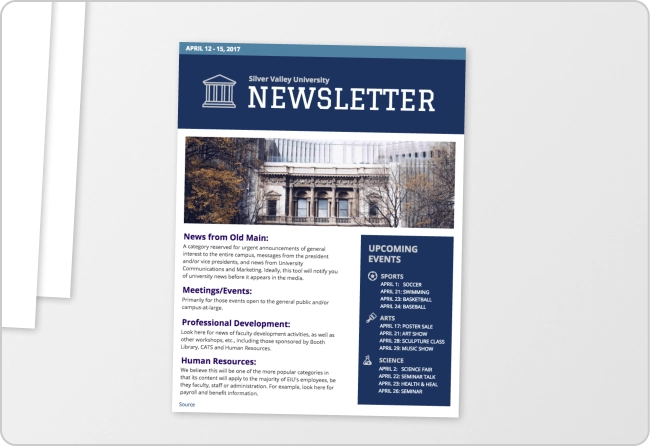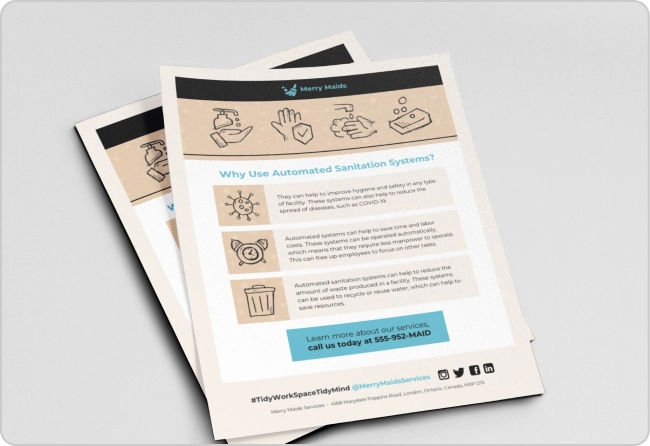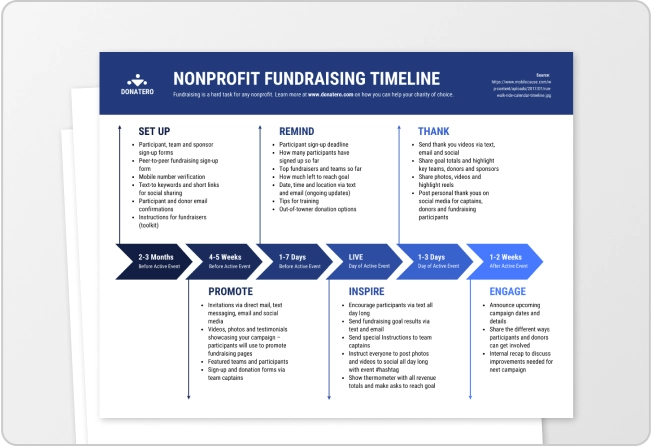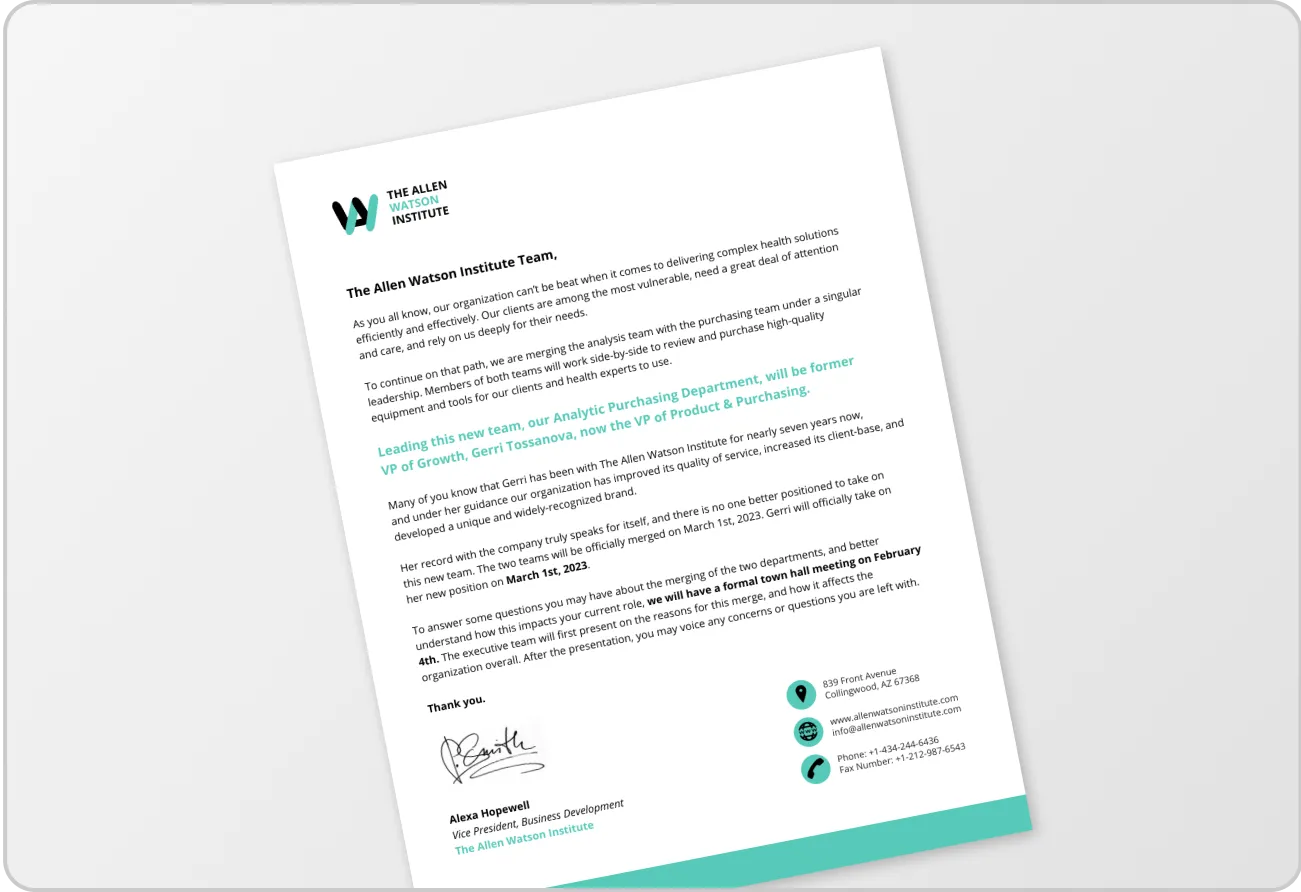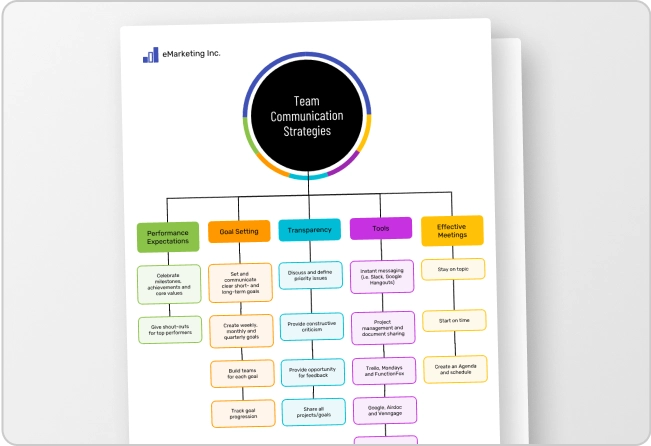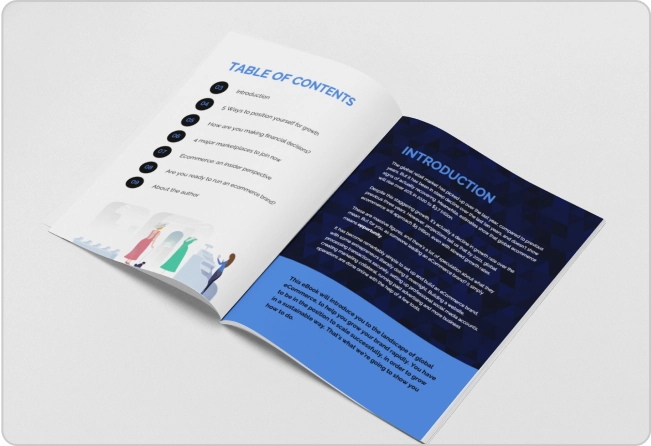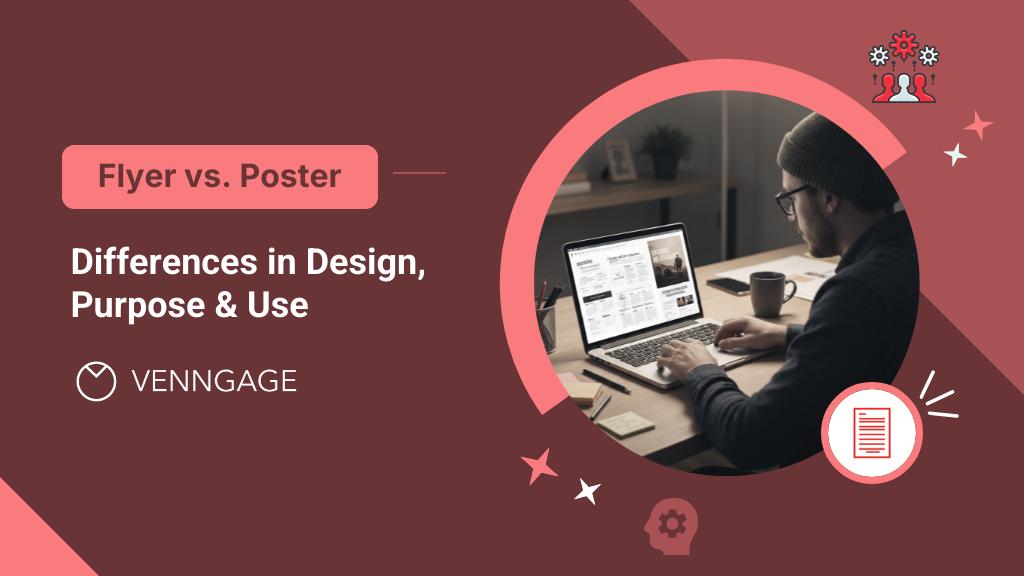
You can promote your business digitally in countless ways, but traditional marketing strategies still work wonders. Handing out flyers in person or mailing them directly to customers, putting up posters on busy streets or in storefronts — these are simple, effective ways to get noticed.
The question is, when should you use a flyer and when does a poster work better? They may seem similar, but each has its own purpose. In this guide, I’ll break down flyer vs. poster in detail. You’ll learn their key differences, where each works best and how to decide which one to use for marketing purposes.
Flyer vs. poster: Key differences at a glance
Here’s a quick overview of the difference between flyers and posters:
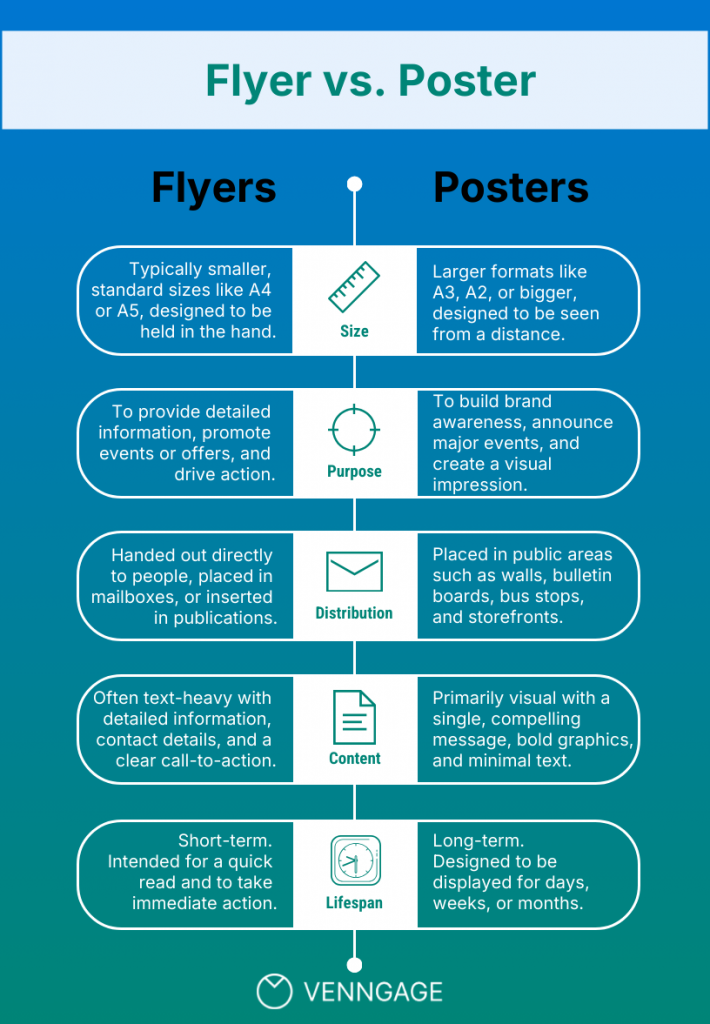
What is a flyer?
A flyer is a one-page document that shares information about your product, service, event, offers, or any upcoming activity. Its purpose is to create awareness and encourage people to take immediate action, like attending an event, redeeming an offer or contacting your business.
You’ve probably seen them everywhere. Someone hands you a colorful piece of paper outside the subway, you find one tucked under your car’s windshield wiper or it arrives in your mailbox along with the bills.
Flyers are work well in digital formats, such as PDFs or images. You can use them as social media posts and email attachments or embed them on landing pages for product or event promotion.
Research by Data and Marketing Association states that 38% of flyers are kept for at least a few days and 13% are kept for over a week. People are also most likely to keep money-off flyers for at least a week.
Attributes of a flyer
- Size and format: A flyer design is usually printed on A4, A5, or half-sheet sizes. They’re compact and easy to distribute.
- Distribution: You can hand out flyers directly to your customers or prospects, add them to mailers, or place them at stores, events and community spaces. They are good for targeted distribution strategies.
- Design elements: A flyer usually contains more information than a poster. They can include key details about the product, service, or event. You can add dates, times, locations, contact information and a clear call-to-action. According to Next Day Flyers, “Adding QR codes, social handles or AR makes flyers more engaging and actionable.”
- Cost and material: They are usually printed on lightweight paper stock and are inexpensive.
- Use cases: Flyers prove most effective for promotional marketing, discount campaigns, event promotion, product launches, menu distribution and lead generation initiatives. They work particularly well when you need an immediate response.
Here’s a flyer example for promoting business services. You can use this business flyer template to promote your services and add a a clear QR code CTA (Scan to Book a Consult) to encourage readers to take action.
According to research by Data and Marketing Association, 89% of people remember receiving a flyer in the mail, making it one of the most memorable forms of advertising.
What is a poster?
A poster is a large-format printed marketing material that is used to advertise a product or service, share important information, or simply grab attention. It combines bold visuals with minimal text to convey a message quickly.
Unlike flyers, which are designed for hand distribution, posters are created to be displayed in public spaces where they can be viewed from a distance. The main purpose of a designing a poster is to attract attention, build awareness and leave a lasting visual impression on the audience.
According to a study by Out of Home Media, posters increase sales by 29.8%, making them an effective promotional tool.
Attributes of a poster
- Size and format: Posters are usually printed in large dimensions such as A3, A2, or A1, making them visible in public spaces.
- Distribution: You’ll see posters on walls, boards, shopfronts and other high-traffic areas where many people can see them.
- Design elements: To make your poster stand out, use bold images, striking colors and short, impactful copy. The headline or key message dominates, while details are secondary.
- Cost and materials: A poster has a higher printing cost than flyers. That’s because they are often produced on thicker or durable stock to last longer on display.
- Use cases: Posters work great for promoting concerts, festivals, awareness campaigns, product launches and brand advertising.
Here’s an example of a poster for an event. This template has a gradient, textured background with bold colours, a big headline to grab attention and minimal text. You can use this poster design to promote music or art events.
Here’s a real example from Slack’s Instagram promoting their event. Notice how this marketing poster keeps text to a minimum and leans on bold graphics instead. Plus, the decorative elements like confetti and geometric shapes create visual interest.
Source: Slack
Related: 12 Types of Posters for Every Business Need [Templates Included]
You can also check out more poster design ideas, tips and templates in this video.
Flyer vs. poster: How do they compare?
A flyer is all about direct communication and immediate action. It’s small, easy to hand out or share digitally and packed with the specific details people need to make decisions. The goal is to get someone to act right away — show up at an event, use a coupon or sign up for a service.
A poster works differently. It’s built for maximum visibility and long-term awareness. Posters are designed to be noticed from a distance, which is why they use bold visuals and minimal text. Instead of providing every detail, they grab attention quickly and build brand recognition that sticks over time.
| Aspect | Flyer | Poster |
| Purpose | Share details, drive quick action (buy, attend, sign up) | Capture attention, build awareness, reinforce visibility |
| Size and format | Small (A4, A5, half-sheet) | Large (A3, A2, A1 or custom) |
| Distribution | Handed out, mailed, stacked at events or venues | Displayed in public spaces, shopfronts, walls, billboards |
| Design focus | More text, details, contact info, CTA | Bold visuals, minimal text, strong headline |
| Cost and lifespan | Low-cost, lightweight, short-lived | Higher cost, durable, longer display life |
Related: Flyer vs Brochure: What’s the Difference and When to Use Each
How do flyer and poster designs compare?
The design strategies for flyers and posters fundamentally differ because they serve distinct marketing objectives.
Flyers are built for detailed communication. Since people hold them close and have time to read, the design can accommodate smaller fonts, multiple information sections and comprehensive details. The challenge is balancing information density with visual appeal to avoid overwhelming readers while providing everything they need to take action.
Posters operate on the “three-second rule.” They must communicate their core message before someone walks past. This requires strategic visual hierarchy with bold headlines, striking imagery and minimal supporting text. Every design element serves the goal of instant recognition and memorable impact.
The fundamental difference: flyers function as detailed guides, while posters work as visual magnets.
- Typography: Flyers can use smaller fonts because they are read up close. They combine multiple font weights and sizes to separate headlines, body copy and contact details. Posters, on the other hand, require large, bold typography that can be read from a distance in just a few seconds.
- Visual hierarchy: There’s often a clear visual hierarchy in flyers — headline at the top, supporting details in the middle and the call-to-action at the bottom. A poster uses hierarchy differently, often relying on one dominant visual or headline supported by minimal text, so the message is instantly clear.
- Readability distance: Flyers are designed for close reading, which allows them to carry dense information in smaller fonts. Posters are designed for far viewing, so the design must be simplified, with short text and strong imagery that stands out.
- Density of information: Flyers usually pack in more content: dates, times, locations, offers and contact details. The goal is to give readers everything they need to act. Posters focus on a single message or idea. Too much information reduces their impact.
- Branding: Flyers include detailed brand elements such as logos, color palettes, contact information and sometimes even secondary graphics or icons. Posters emphasize brand recognition through strong visuals and consistent use of colors or logos but keep supporting details minimal.
- Calls-to-Action (CTA): Flyers almost always include a specific CTA — “Visit our website,” “Scan this QR code,” “Call to register.” Posters may include a CTA, but often the goal is awareness first and action second. A typical poster CTA is short and visual, like a URL or hashtag.
- Imagery: Flyers use imagery to support information (product photos, service visuals, event snapshots). Posters rely heavily on imagery as the main communication tool — a striking photo or graphic often is the message.
- Layout flexibility: Flyers can have multiple sections and a denser layout. Posters need more negative space so the central message doesn’t get lost in clutter.
Let’s compare flyer vs. poster using examples:

The flyer design on the left uses classic direct marketing principles. Notice how it’s packed with specific value propositions like “$5 Wing Buffet,” “½ Price Apps,” and exact pricing for different game day specials. There’s substantial text, multiple offers and detailed terms at the bottom. This information-dense layout assumes someone will hold it close and actually read through the details.
The event poster design on the right takes the opposite approach, focusing on brand awareness and visual impact. The main message “Future Economic Treat Business Conference” uses bold typography to grab attention from a distance.
You can also see the practical differences in how they handle information hierarchy.
- The flyer uses multiple sections, bullet points and detailed pricing because someone receiving it has time to process all that information.
- The poster keeps it simple with just the essential details because viewers might only have a few seconds to notice the message.
How to design flyers and posters?
Creating professional flyer designs and poster layouts doesn’t require extensive design experience or starting with a blank canvas.
Venngage’s AI Flyer Generator and AI Poster Generator can turn your text into ready-to-edit designs.
Just add your marketing objectives, key messaging and basic content details. The tool analyzes your requirements and creates multiple layout options optimized for your specific format. You can then customize the AI-powered flyers or posters with your brand colors, logos, imagery and call-to-action elements to match your business identity.
Here’s how to do it:
If you want more hands-on control, you can also create the design using a template. Venngage offers hundreds of customizable flyer designs and poster templates across different categories. Pick one that aligns with your theme and use the AI Autofill feature to create a custom design within seconds.
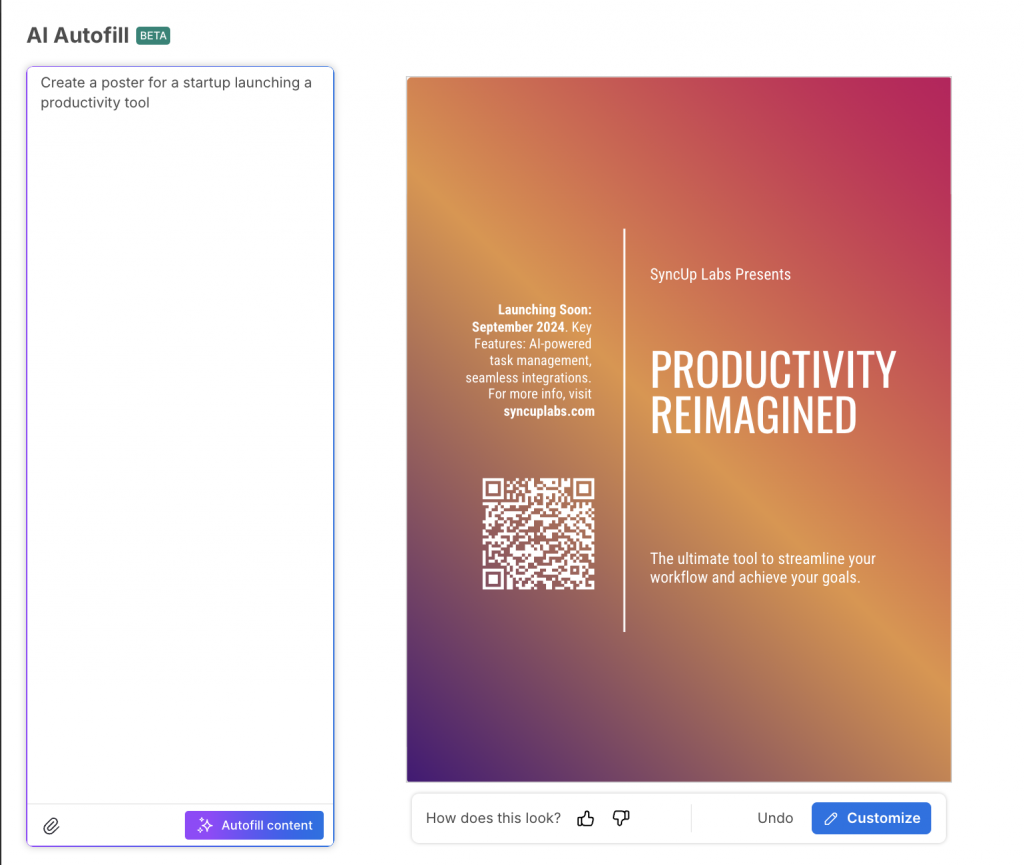
Related: 9 Best Flyer Design Software in 2025 (Free & Paid Tools Compared)
When to use flyers and posters for marketing purposes?
From a marketing perspective, flyers and posters fulfill different roles in the campaign funnel.
Flyers excel in conversion-focused marketing. They work best when you need direct response and measurable action from your audience. Think discount codes, QR codes linking to landing pages, detailed event information, or product demonstrations.
The format is designed to be retained, referenced and shared, making flyers ideal for promotional campaigns and lead generation initiatives.
According to the American Marketing Association, “Flyers are a straightforward and budget-friendly marketing technique that involves distributing printed advertisements in targeted areas. This approach, often referred to as ‘carpet-bombing,” allows businesses to reach a wide audience quickly.”
Posters, on the other hand, are more awareness-driven. Their purpose isn’t to communicate every detail but to leave a strong impression. Whether it’s a festival lineup, a new product launch, or a social awareness campaign, posters are about making people stop, notice and remember.
In practice, the smartest campaigns use both formats together. For example, a SaaS company launching a new platform could display posters in co-working spaces with a bold headline like “Work Smarter with [Product Name]” while distributing flyers at industry events with product details and a QR code to start a free trial. The poster builds recognition; the flyer drives action.
Here’s a quick checklist on when to use a poster vs. a flyer.
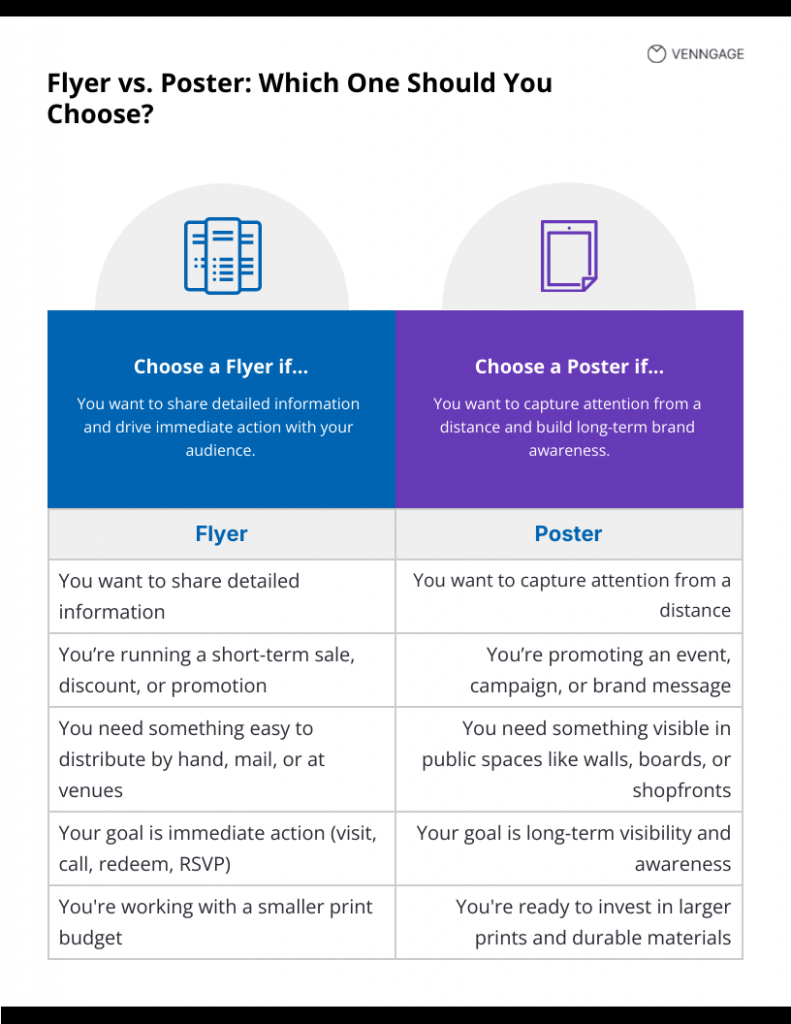
Related: How to Make a Poster in PowerPoint: Step-by-Step Guide
Frequently asked questions
1. Is a flyer considered advertising?
Yes. A flyer is a form of advertising because it promotes a product, service, or event to a target audience. It can be printed or digital and its purpose is to raise awareness and drive action — whether that’s attending an event, redeeming a coupon, or signing up for a service.
2. Which is more cost-effective: flyers or posters?
Flyers are generally more cost-effective. They are smaller, cheaper to print in bulk and easier to distribute by hand or digitally. Posters are larger, use more material and are often printed on higher-quality stock to withstand display, which makes them more expensive per unit.
3. What are the disadvantages of flyers?
Flyers are short-lived — many are discarded quickly after being handed out. They have limited reach compared to posters because distribution relies on one-to-one contact. Flyers can also look cluttered if overloaded with information, which reduces their effectiveness.
4. What is the main difference between a flyer and a poster?
A flyer is small, detail-oriented and designed for close reading and immediate action. A poster is large, visual and designed to grab attention from a distance and build awareness.
5. Can flyers and posters be used together?
Yes. Many campaigns combine them. Posters create buzz and visibility in public spaces, while flyers provide details and a direct way for people to take action.
6. Which is better for event promotion: a flyer or a poster?
Posters are better for building awareness and visibility, while flyers are better for sharing event details and nudging people to RSVP or attend. For maximum impact, both should be used together.
Create flyers and posters with Venngage
Flyers and posters are not interchangeable. Each format has its own strength and the right choice depends on whether you need to drive immediate action or build long-term awareness.
A flyer helps you share detailed information and push a response right away. With a poster, you can capture attention and make your message memorable in public or digital spaces.
With Venngage, you can create both flyers and posters quickly using professional templates. The drag-and-drop editor and AI-powered design suggestions make the process simple, so you spend less time fiddling with layouts and more time creating materials that stick with your audience.




























